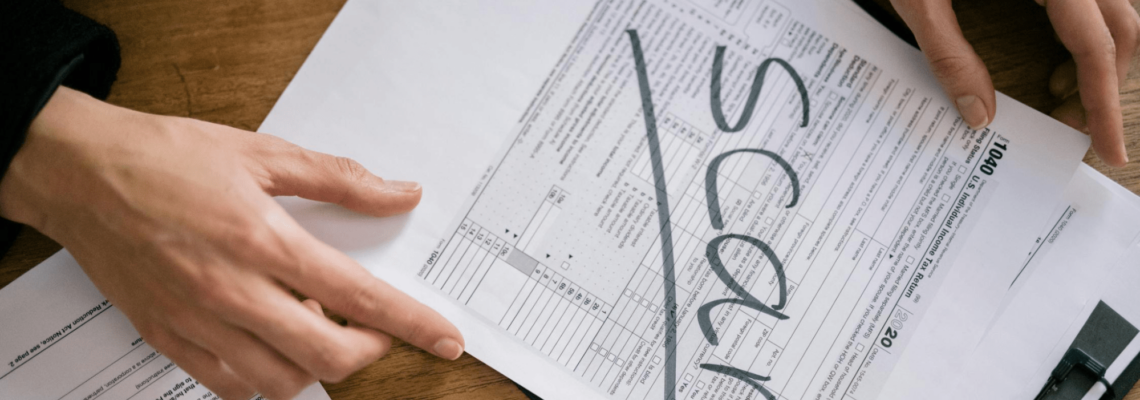
An Association for Financial Professionals survey of treasury professionals revealed that checks remain the payment method most prone to fraud, with 65% of respondents reporting fraudulent activity.
Unlike in-person transactions, e-checks lack the same level of protection, making them an attractive target for scammers.
So, can you get scammed with an e-check? We’ll answer this question in more detail and discuss how you can protect yourself from e-check fraud.
Can You Get Scammed With an E-Check?
Yes, you can get scammed with an e-check. In digital scams, criminals use stolen bank account information to create fake checks. When these checks are deposited, it may take some time before the bank realizes they’re fake. By that time, the scammer could have already taken your money.
How Does an E-Check Scam Happen?
Scammers obtain bank account details and routing numbers through data breaches, past invoices, or the checks themselves.
Many companies share account numbers with vendors to allow direct payments or transfers. Scammers can also use this information for fraudulent purposes.
Here’s how a typical e-check scam unfolds:
- A scammer pretends to be a customer and makes a large payment using an online check
- Before the check clears, the scammer pretends to change their mind and asks for a refund, either full or partial
- Since e-checks can’t be refunded like credit or debit card payments, the business sends a refund check to the scammer
- The original e-check bounces, leaving the business without the original payment from the scammer
In another type of e-check scam, fraudsters might email you an image of a check, calling it an electronic check, and ask you to deposit it into your bank account. Note that no legitimate company will use an emailed image of a check for any transactions.
Who Is at Risk of an E-Check Scam?
Anyone can be at risk of an e-check scam, but scammers have common targets. They include:
- Online sellers—If you use online marketplaces like Craigslist or eBay, be wary of buyers who want to pay with an e-check, especially for expensive items
- Job seekers—Fake job offers that promise a big paycheck via an e-check are a red flag. While legitimate jobs also offer attractive salaries via e-checks, if an offer is too good to be true, it’s probably a scam
- Non-profits or people who help others—Scammers may target compassionate people responding to online pleas for help with an e-check donation
- Anyone in a hurry—If you’re strapped for cash or excited about a deal, you might rush into depositing a fake e-check without checking it thoroughly
Midsize companies are particularly vulnerable because they have more transactions than small businesses but lack larger companies’ advanced fraud detection systems.
What To Do if You Get Scammed via an E-Check

Taking prompt and effective action can minimize the damage from an e-check scam and help you recover your funds. Here are the steps to take if you find yourself a victim:
- Inform your bank
- File a police report
- Submit a claim to your insurance
Inform Your Bank
The first step you should take is to contact your bank immediately to report the fraud. Provide them with all the details about the transaction, such as:
- The check amount
- Date and time of the transaction
- Proof of communication with the scammer
The sooner you report the issue, the better the chances of recovering your money.
Some banks have fraud protection services that can help you recover lost funds. If you don’t have this service, consider enrolling in it for future protection.
You should also change your online banking passwords to secure your account from further unauthorized access.
File a Police Report
A police report documents the details of the scam, including the stolen amount and the way it happened.
Filing a police report has two benefits:
- It creates an official record of the scam, which is useful if you need to prove the fraud to your bank, insurance provider, or other authorities
- It helps law enforcement track and investigate fraud cases and potentially prevent others from becoming victims
Support the report with any evidence you have, such as emails, text messages, transaction records, and any other documentation related to the scam. Ask for a copy of the report after filing it since you may need this document when dealing with the authorities involved in resolving the situation.
Submit a Claim to Your Insurance Company
Some insurance policies offer protection against financial scams like e-check fraud.
Review your insurance policy to see if it covers fraud or cybercrime. If it does, gather all the necessary documents and fill out the claim forms accurately.
To file an insurance claim for an e-check fraud, you’ll need the following documents:
| Document | Description |
| Police report | A copy of the police report you filed documenting the e-check scam |
| Bank documents | Bank statements showing the fraudulent transaction and any communication with your bank about the scam |
| Proof of the fake e-check | A printout of the fake e-check |
| Documents showing communication with the scammer | Copies of emails, text messages, or any other communication you had with the scammer |
Submit your completed forms and wait until the insurance company reviews your claim and decides whether to approve it.
How To Prevent E-Check Scams
If you want to protect yourself against e-check scams, here are three best practices to follow:
- Don’t refund directly
- Don’t rush into refunds
- Sign up for a secure banking platform
Don’t Refund Directly
If someone asks for a refund on their e-check payment, don’t issue it yourself. Instead, contact your payment processing service provider. They can collaborate with the ACH Processor, the company handling e-check transactions, to manage the refund.
The process may take a few days, but it’s a safer option when you have concerns about the validity of the transaction and want to protect yourself from scams.
Don’t Rush into Refunds
Scammers try to pressure targets into refunding an e-check quickly, especially before it’s cleared by the bank.
The safest approach is to wait until the e-check payment has been fully cleared by the bank before taking any further action.
E-checks typically take three to five days to get cleared, so it’s a good idea to wait for at least five days.
Use a Secure Banking Service
Consider switching to a secure banking service that disables ACH debits to your account. FortKnox by Austin Capital Bank is an online banking platform that focuses only on fraud protection.
Apart from disabling ACH debits to your account, FortKnox restricts external fund transfers to only a single pre-approved account. This makes it an excellent place to store important business funds and personal savings.




